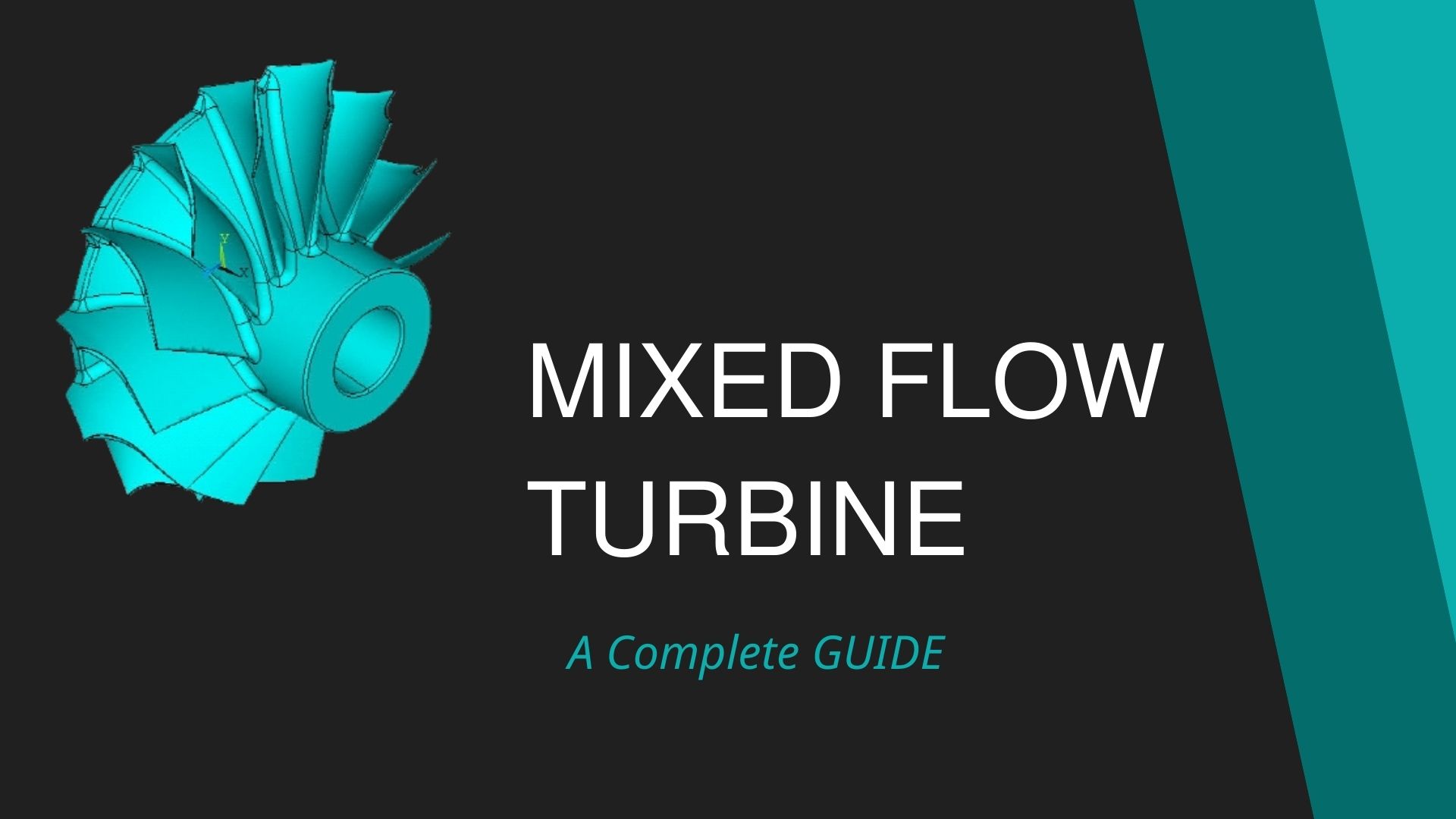A mixed flow turbine is a cross between an axial and a radial turbine, it possesses characteristics of both. The inlet flow in a mixed flow turbine is at an angle between the complete radial and the axial design. In comparison to a radial turbine, this reduces flow path curvature and thus secondary flow formation.
Mixed Flow Turbine: Fundamental Concept
The mixed flow turbine design combines ideas from two distinct types of turbines. This is why they are referred to as “mixed flow turbines.” This type of turbine combines axial and radial turbine designs. The fluid enters in a tangential direction straight from the top of a circle to the left or right in a radial turbine and spirals. Assume that the water spiral causes the fan blades to turn in the same direction as the water. This is the fundamental idea behind a radial turbine.
A radial turbine, on the other hand, uses a fluid that flows perpendicular to the blades of a rotor rather than in the same direction. The most common type of axial turbine is the windmill. The rotor blades in a windmill are designed to trap wind as it blows through them.
The Benefits of Mixed Flow Turbines
The axial turbine’s efficiency ranges between 70% and 75%. This is because there is a space between the rotor blades for fluid to pass through. To capture all of the air blowing at a windmill, the windmill had to be a complete, solid circle. By the way, if the windmill were a complete solid circle, the air would not be captured in a useful way by the turbine, implying that there would be no axial turbine with 100 percent efficiency.
The radial turbine has an efficiency of around 80%. The reason for the lower-than-perfect efficiency is a phenomenon known as “secondary flow.” We can consider the toilet as an example: when you flush the toilet, the water outside the bowl does not always circulate evenly with the rest of the water. This is referred to as the secondary flow of the toilet water. The more secondary water there is in the flow, the less water there is to turn the fan. As a result, efficiency is minimum.
When both of these designs are combined, the efficiency rises to around 85 percent to 90 percent because the fluid enters radially in a mixed flow turbine, the secondary flow is minimized, and the efficiency of the axial turbine part is maximized with a forced fluid flow. It may not appear to be a significant increase in efficiency, but on a large industrial scale where energy costs millions of dollars, even a small increase in efficiency can save a lot of money.
The turbine control systems safeguard and improve the efficiency, and safety of the powerplants. IS200DTCIH1A, and IS200TBCIH1B are some GE turbine control parts examples.
Mixed Flow Turbine: Applications
The mixed flow turbine was such a popular design that it is still in use today. Modern car turbochargers, for example, use mixed flow air intake systems to maximize the amount of air entering the engine cylinders. More air means more explosions in the engine compartment, which results in increased power output.
When the engine speed increases, the engine requires more air at a faster rate. The turbocharger contributes to this need for more air because the number of engine revolutions (rotational speed) increases the number of times the fan in the turbocharger rotates. Despite using a design that is more than 100 years old, the turbocharger is an essential component in many types of auto racing.
Turbochargers
Part-load performance is critical for designing and engineering automotive turbocharger turbines due to the increasing demand for improved fuel consumption in passenger cars. It is preferable in an automotive drive cycle to have a turbine that can obtain more energy at high-pressure ratios and lower rotational velocities.
Radial turbines are typically found to be most efficient at speed ratios of 0.7. The blade speed ratio is low at high-pressure ratios and low rotational velocities, and the rotor experiences high values of positive incidence (the difference between flow angle at the inlet and blade angle at the leading edge of the rotor) at the turbine inlet. According to primary considerations, mixed flow turbines offer significant benefits for such purposes.
Hydraulic Turbine
This link will be extremely useful if you want to learn the fundamentals of water turbines. In a propeller-type mixed-flow reaction water turbine, water flows through the runner radially first, then axially relative to the turbine axis. Water flows from the turbine casing to the stator’s guiding mechanism. The draft tube is typically curved in shape.
Of all the hydraulic turbine types, mixed flow turbines have the highest optimum efficiency. The performance characteristic curves of mixed flow turbines, on the other hand, are not as flat as those of adjustable-blade turbines. As a result, in hydraulic power plants where the head varies greatly and the number of units is small, mixed flow turbines are inferior to turbines with adjustable blades for power generation. The cavitation characteristics of mixed flow turbines, on the other hand, are noticeably better than those of adjustable-blade turbines.
Also Read: Lead Generation for B2B Companies: Strategies That Work
Francis Turbine
Francis turbines are widely used due to their wide range of hydraulic heads, which range from three to 600 meters. The output and flow rate in high heads must be high; otherwise, the runner will be too small for reasonable manufacturing. Except for small power outputs, propeller turbines are typically more efficient at low heads.
Francis turbines are excellent in the medium head range of 120 to 300 meters and are available in a variety of sizes and designs. They can have shafts that are horizontal or vertical. Vertical-shaft turbines are used in machines with diameters of two meters or greater, and they typically take up less space than horizontal machines. This allows for greater submergence of the turbine runner with minimal deep excavation, as well as easy access to the generator mounted on the tip for maintenance.
Horizontal axle units are more compact for smaller sizes, making it easier to access the turbine. However, as the size of the generator grows, it becomes more difficult to remove it for repair.
The most common Francis turbine design has a welded or cast-steel spiral casing. This component aids in the even distribution of water across all inlet gates, which may include up to 24 pivoted gates or guide vanes. The gates operate from fully closed to fully open, depending on the desired power output.
Also Read: Lead Generation for B2B Companies: Strategies That Work
Deriaz Turbine
In medium-sized units, a Deriaz mixed flow turbine employs swiveled, variable-pitch blades to improve performance at part loads. Deriaz’s design has been applied to higher head applications as well as some pumped storage applications. It has a lower runaway (sudden loss of load) speed than the Kaplan turbine, which results in significant savings in generator costs. However, only a few Deriaz turbines have been constructed.
Also Read: What Is The Meaning Of A Root Software?


